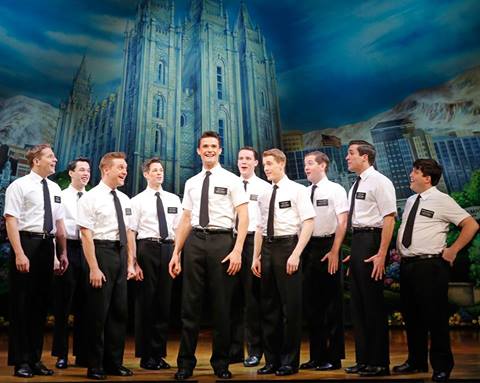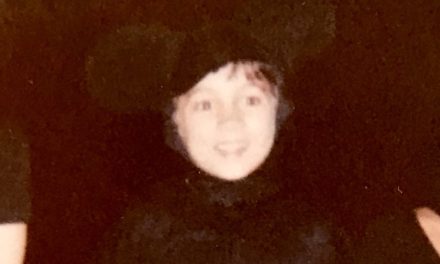The cast of Book of Mormon. Photo-PNC Broadway
Book of Mormon
Book, Music & Lyrics by Trey Parker, Robert Lopez & Matt Stone
Directed by Casey Nicholaw & Trey Parker
Choreographed by Casey Nicholaw
Review by Kathi E. B. Ellis
Entire contents copyright © 2014 by Kathi E. B. Ellis. All rights reserved.
This week Louisville audiences finally got to see and hear why Book of Mormon has been so popular since premiering on Broadway in 2012 and garnering nine Tony Awards that season. The current national tour, playing in the Whitney Theatre at the Kentucky Center for the Arts, brings fresh-faced energy and pizzazz to a musical that is at once both comfortably traditional in form and also outrageous, camp, and politically incorrect in equal measure. The young missionaries are just so gosh-darned nice that audiences can be forgiven for buying into the Book of Arnold by the end of the performance.
Co-creators Matt Stone and Trey Parker take on the two years of missionary work on which young Mormon men embark. In so doing, they are set up to poke fun at the Mormon faith – taking a side swipe at Jewish practices – American materialism, African culture, Hell, and almost everything else that Elders Price (Mark Evans) and Cunningham (Christopher John O’Neill) encounter. One whole number is dedicated to the ‘F’ word, which had the opening night audience in peals of laughter – possibly a new experience for Broadway Series regulars. And yet, Stone and Parker also successfully embrace the naïveté of young missionaries and the world-weariness with which their would-be converts initially receives their overtures. The premise works because, despite a relatively closed Mormon culture, the general populace recognizes certain stereotypes and clichés of the religion, which gives them an entrée into the culture being parodied.
‘Hello’ is a delightful opening number, establishing a routine familiar to all: the doorbell ring of the proselytizer. Preceding that there is a prologue which echoes the dioramas in the church history museum in Salt Lake City – though the tableaux’ characters come to life and speak their history (albeit an adulterated version). Thus prologue and opening number ground what is to come. Though little else is grounded, as we are treated to a deconstruction of an apparently-exotic African saying ‘Hasa Diga Eebowai’; a mock anthem to repressing emotions ‘Turn It Off’; a bawdy, Technicolor rendition of ‘The Spooky Mormon Hell Dream’ and the villagers’ presentation of ‘Joseph Smith American Missionary’.
This high-energy company does justice to the predominantly up-tempo score (Parker, Stone and Robert Lopez) and fleet-footed choreography (Casey Nicholaw). And it is an ensemble company. While there are characters that are stand-alone, so many of the company play multiple roles it is this that shines through in their performance—and is the strength of the production. Evans and O’Neill have a charming chemistry on stage as the mismatched partner missionaries, with Evans’ self-centered energy propelling the story forward until O’Neill’s klutzy bonhomie takes the reins in converting the villagers. Grey Henson’s repressed Elder McKinley is a high-octane leader of the mission, also stepping out to embody Moroni in the opening tableaux of each act. Alexandra Ncube as Nabalungi – a name fated to be mangled constantly by Cunningham – provides the heart of the story as she becomes a believer and brings her village with her. Her paean to the home of Mormonism, ‘Sal Tlay Ka Siti’, is a traditional heartfelt ballad, placed towards the end of Act One, at a time when the audience is receptive to this change of tone.
The production design is impressive. Scenic designer Scott Pask creates an arguably recognizable African village as well as larger than life painted backdrops for Salt Lake City and Orlando; the backdrop to the village is evocatively lit by lighting designer Brian McDevitt (both won Tony Awards for their designs) while Ann Roth’s costume designs are both highly recognizable (the ‘uniform’ of the Mormon missionary) and delightfully tongue in cheek comments on The Lion King – a frequent reference, both overt and implicit in the script. There are many other tips of the hat to musicals, from A Chorus Line to The King and I, and everything before and since. These embedded allusions provide an aural cultural touchstone – frequently accompanied by chuckles and head nodding from Wednesday’s audience.
Any quibbles I have are relatively minor, and have more to do with the venue. As always the impressive towers of speakers at each side of the Whitney stage mean that the lyrics are overwhelmed by the music for those audience members seated directly in front of the speakers. The side sightlines from this vantage also mean that these audience members also see performers crouched behind set pieces preparing for entrances when it doesn’t make sense for them to leave stage briefly. The biggest disappointment of the evening is no listing of musical numbers in the Audience playbill, a service that typically allows audience members to recognize and appreciate individual performers throughout the performance.
Book of Mormon brings to a close the current Broadway Series season
And a rousing finale it is. Of the four productions I saw this season, this is the one that will be a highlight for me. In The Addams Family, the performers exceeded the material, Ghost was underwhelming and, as much as the spectacle of War Horse was impressive, the night I saw it the human, and horses’, stories were overwhelmed by the design elements. In Book of Mormon, all of the elements – as in the golden age of the American Musical – came together in a cohesive and balanced way to serve the overall production.
Here’s to the 2015-2016 season!
Book of Mormon
May 27-June 8, 2014
PNC Broadway in Louisville
Kentucky Center for the Arts
501 West Broadway
Louisville, KY 40202





